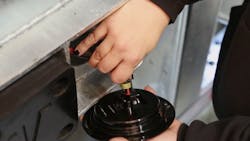An inoperable vehicle lamp gives the appearance that a vehicle is not being optimally maintained. Lamp failures are easy to spot, even from afar, and while a vehicle is stopped for the lighting infraction, a more thorough Compliance, Safety, Accountability (CSA) roadside inspection is likely to happen.
Hours may lapse before a vehicle gets back on the road. If a roadside service call is required, it can be even longer.
In today’s trucking environment, the failure of a $5 lamp can cost literally hundreds, if not thousands of dollars in service fees, lost vehicle and driver productivity, fines for violations and points against the driver’s and fleet’s CSA scores.
“Why give the authorities a personal invitation to stop a vehicle?” asks Brett Johnson, president and CEO of Optronics International (http://optronicsinc.com), a worldwide manufacturer of industrial and commercial vehicle safety lighting products. “The right equipment, coupled with a sound maintenance and inspection routine, allows maintenance staff and drivers to identify and correct the majority of lighting- and wiring-related problems before a vehicle hits the road.”
SYSTEM INTEGRITY
“Sound lighting and electrical system integrity is critical to avoiding CSA infractions,” says Johnson. “These systems are foundational to the smooth operation of any vehicle and are indicative of the vehicle’s overall operational soundness. In turn, a properly operating vehicle helps drivers and fleets comply with CSA requirements, and that is in the interests of the vehicle OEM, end-user and the general public alike.”
Based upon U.S. DOT weighted guidelines, infractions dealing with defective or inoperable lighting rank higher in importance than brakes and carry higher CSA point penalties in relationship to other infractions, he notes. Unfortunately, what appears to be a failing lamp, ultimately may prove to be a more insidious problem of systemic corrosion.
CORROSION
“Corrosion is like an infection that manifests itself within a vehicle’s electrical system, much like some forms of disease,” Johnson of Optronics says. “When the right steps are not taken to prevent corrosion, just like a biological infection, it can spread throughout a vehicle, significantly shortening its life and that of its electrical system.”
Johnson compares a vehicle’s wiring and harness system to the human body’s vascular system. He explains that corrosion can travel the length and breadth of a vehicle through its electrical infrastructure, wreaking havoc on each component it encounters.
Corrosion is commonly caused when moisture invades a vehicle’s electrical and power delivery system. The electrical and wiring system can be breached anywhere along its surface and through, leaking lamp connections, broken lamp housings/lenses and cable and wire abrasions. Road debris, moving parts and temperature extremes can lay siege to a system.
THE WEAK LINKS
Lighting and electrical system connections are the weakest link. An LED lamp is usually attacked at its most vulnerable location – its electrical connection. If a lamp has not been properly maintained, it can die needlessly and long before its potential service life.
Today’s LED lamps are often designed to use dielectric grease and modular connection designs to resist moisture at the connection point, but must be inspected regularly and the grease replaced when needed, says Johnson. Some fleets apply heat-shrink moisture barriers to all electrical connections as an added barrier of protection.
Seasonality effects CSA-related lighting and electrical problems, he adds. Corrosion can be accelerated as a result of chemicals used to treat road surfaces.
“Vehicles in the northern regions will unavoidably encounter corrosive elements during colder months,” Johnson says. “Road spray causes chemicals to accumulate on equipment and electrical systems alike.
“Corrosion due to chemical exposure is common on heavy duty trailers, because the harness system remains largely exposed to the elements.
With maintenance of lighting and electrical system integrity being the key to avoiding CSA problems, Johnson recommends additional inspections of all equipment during winter months and extra care and maintenance of the vehicle’s electrical system.
About the Author

